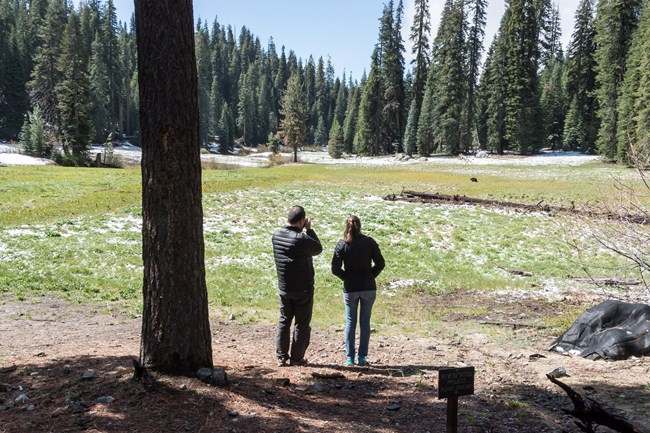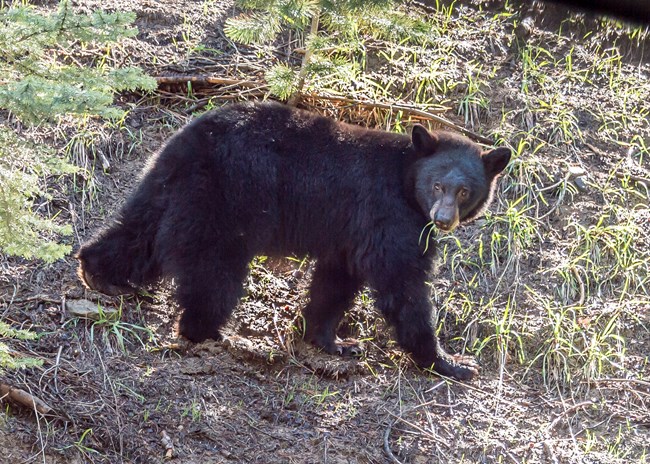
Tips for Wildlife SightingsThese parks host an incredible diversity of life across a range of elevations. Depending on where you visit and when you travel, you have an excellent chance of seeing at least a few different species of animals during your visit. Seeing wildlife in a natural setting can be a great experience, as long as you’re careful. When viewing animals in the parks, keep a few things in mind:
How far away should you be?Observe all wildlife from at least 75 feet (23 meters) away. That's the length of two school buses. Watch more dangerous animals like black bears from at least 150 feet (46 meters) away. That's the length of four school buses. 
NPS/ Alison Taggart-Barone Protecting Wildlife and YourselfRemember: All animals in the parks are wild. What are the possible risks of not safely watching wildlife? Risks to you:
Risks to wildlife:
Types of WildlifeAmphibians occur at all elevations within Sequoia and Kings Canyon National Parks. You may see some species only seasonally while others may be found at all times of the year. Their occurrence ranges from common (Pacific treefrogs) to extirpated, or locally extinct (foothill yellow-legged frogs). In addition to the two endangered species of mountain yellow-legged frogs and the extirpated foothill yellow-legged frog, eleven other amphibian species live in the parks.
Read more about the amphibians in the parks. The parks are home to 17 species of bats! You can find them from the lowest elevations to over 10,000 feet. Three bat species in the parks emit calls audible to the human ear; listen for them at night, and look for their quick, erratic flight patterns as the sun is setting.
Over 200 species of birds can be found in the skies of Sequoia and Kings Canyon National Parks. From the iconic California quail to the rarely seen northern pygmy owl, birding opportunities are endless. Read more about the birds of Sequoia and Kings Canyon National Parks.
All bears in the parks are American black bears (Ursus americanus), but the name “black bear” name can be misleading. They may be black, brown, cinnamon, or even blonde in color. An adult female can even have cubs that are different colors. The best places to find bears are those locations that serve as food sources at that time of year. In spring, bears are often in meadows digging up grasses, forbs, and roots, or in the forest ripping apart logs for the insects inside. As berries ripen in summer, bears can be found near manzanita and bitter-cherry bushes. In the fall, you may see bears high in oak trees, consuming vast quantities of acorns. When bears and humans get too close, the result can be disastrous -- for you and the bear. Bears change their behavior if they become habituated to humans (get used to our presence). This happens if we crowd them or observe them too closely. For both your safety and the bears’, keep a safe distance away, and never offer bears food. If you see someone else trying to feed a bear, please report it immediately. If you find yourself near a bear and/or if a bear has obtained human food, try to deter the bear. Wave your arms, make loud noises, and throw small rocks in its direction (but please avoid hitting its face or head). Keep a safe distance but be persistent. If a bear does get human food, never try to take it back. Fish can be found throughout park rivers. The parks are home to 5 native fish species and 6 non-native introduced species. For those with angling in mind, be sure to obtain a California fishing license and learn more about park regulations on our fishing page.
Read more about the fish in the parks. One of the rarest sightings here is mountain lions. They are extremely shy, and their solitary behavior means that a single animal will occupy a large territory. Though it’s unlikely that a mountain lion will attack humans, follow these tips to reduce the chances even further:
These charismatic animals get their name from their large, mule-like ears. They can be found in many areas of the parks, from the foothills to the sequoia groves. During early summer, look for male deer sporting racks of antlers.
If you find a fawn, keep your distance and do not approach it. Fawns are born with natural camouflage and are relatively scentless, making them hard for predators to find. To help their fawns stay hidden, adult female deer often move away from their fawns during the day, returning regularly to nurse. Do not worry if you see a fawn without its mother; its mother will be back for it. However, if you disturb or move a fawn, the mother will not be able to find it. When a mule deer spots a human, it may freeze and stare back at the unknown threat. Remember to never approach or disturb any wild animal. Enjoy them from a distance. These small, round relatives of the rabbit can be found in the higher elevations of the parks. Look for them scurrying around rocky alpine areas, and listen for their short, quick chirp. Trails into alpine environments are ideal for viewing pika.
Pika forage on a variety of vegetation. Sometimes food is consumed on site, but other food is collected in a "haystack." This is a stack of vegetation left to dry on rocks. Once haystacks have dried, pika carry their food back to their dens. Instead of hibernating, pika eat this food during the winter months. The parks are home to 21 species of reptiles: 14 snakes, 6 lizards, and 1 turtle. Snakes and lizards are a common sight along trails in the foothills and sequoia groves. Listen for the rustling of dry plants to pinpoint their location. Check near streams in the foothills for western pond turtles. Consider bringing a field guide as you hike to identify reptiles you come across.
There are rattlesnakes in Sequoia and Kings Canyon National Parks. If you see a rattlesnake, do not approach it. The only venomous reptile in the parks is the western rattlesnake, though it is important to maintain a safe distance from all wildlife. Prepare by learning how to identify and avoid rattlesnakes. Read more about the reptiles in the parks. Many other animals can be found within the parks, including species that are elusive and rare. Some of these include Sierra Nevada bighorn sheep (endangered), California condors, martens, and gray foxes. If you see one of these animals, ask at any visitor center for a wildlife observation card to report your sighting.

NPS/ Alison Taggart-Barone GuidelinesMinimize your risk of harm and protect wildlife by following these guidelines: Never feed wild animals: Directly feeding wildlife or leaving food unattended or improperly stored is prohibited in the parks. Feeding animals results in unnatural behavior, dependence on humans for food, and poor nutrition. Keep wild animals wild by keeping your food within arm's reach and properly storing all scented items. Learn more about how to store food properly. Maintain a safe distance: Getting too close, feeding, and touching are all things that can put you and your furry, feathered, or scaled counterpart in grave danger. As wildlife become used to humans and lose their natural fear, these animals become aggressive.
If you have a pet with you: Remember, pets are not permitted on trails outside campgrounds. Wild animals carry diseases that can be harmful or even fatal to dogs. These disease can be transmitted when dogs approach or get near wild animals. In addition, some birds, especially nesting birds, are sensitive to dogs. The presence of a dog near a nest can disrupt nesting patterns and may cause birds to abandon their nests. In campgrounds, be aware: Bears and other animals may attack pets, especially dogs. Even deer have been known to attack dogs. Be aware of diseases: Diseases such as hantavirus and plague can be transmitted through rodent feces and fleas. Avoid walking, camping, or allowing pets near burrows or other rodent activity. Do not touch any wild animals. Don’t watch and drive: When viewing wildlife from your vehicle use designated turn outs on the road to avoid congestion and accidents. Don’t stop in the middle of the highway. Calling, clicking, whistling or making noises of any kind to attract wildlife is illegal. This includes playing noises to attract birds, frogs and other amphibians, and mammals. If you enjoy watching animals and these special places, be a role model to others. Demonstrate how we can protect and preserve wildlife through our actions. Review other ways to safely watch wildlife in national parks. |
Last updated: August 28, 2025
